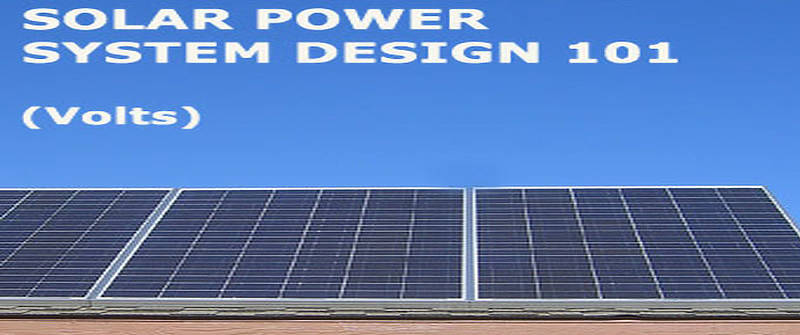Solar Power System Design 101 (Volts)

Volt. Volts. It’s one of the three basic measurements to understand regarding basic electricity. It also relates to solar power system design. The other two important units are Amps and Watts. Lets quickly talk about volts, keeping it pretty simple.
Volts
Think of volts as pressure. When you open a water faucet or hose, the reason that water flows out is because it is under pressure. Volts is the basic unit of measurement for electrical pressure. There are technical definitions that precisely define the volt, but for the sake of keeping it very simple, just remember that volts is ‘pressure’.
(more technical detail via Wikipedia)
Solar Panel Volts
Photovoltaic solar panels are available in a variety of voltages. A typical solar panel is actually made up of an array of smaller individual solar cells which are are wired together (internally). Depending on how they are internally connected will provide a given ‘voltage’ at the output (with full sunlight shining on the panels of course).
Also, solar panels and their voltage specifications are rated under a variety of conditions. Here’s an example.. I’ll list the volts specs for my own solar panels..
- Open circuit voltage (Voc), 45.6V
- Maximum power point voltage (Vmpp), 36.5V
Solar panel volt ratings are important. You may combine them in a series configuration, adding up to a higher voltage. This helps to reduce the cable gauge size needed for the feeds back to the house (higher voltage – less current). But you need to also match it up properly with your solar charger input ratings too. Too high of a voltage and you’ll damage the charger. Too low and you’re losing efficiencies.
For example, my own solar system utilizes several groups of three panels. Each group of three is wired in series. This presents a potential Voc maximum of nearly 137 volts per group going back to the charger.
Additionally, that open circuit voltage will go even higher when the ambient temperature is really cold (solar panels love the cold). I had to factor this in for my location which can get down to -30F. There are formulas for this. In my case, that meant the Voc could reach 162 volts. So I was sure to purchase a charger that could handle at least that (it was rated for 200 volts).
Battery Volts
Batteries also have a voltage rating. They too are typically configured with multiple individual internal ‘cells’ that combine to output a given standard voltage.
One of the typical traditional heavy duty deep-cell batteries used in a solar system power bank may be the 12 volt deep cell lead acid battery. That’s the same voltage as a typical car battery (although a ‘deep cell’ battery is a bit different design than an automotive battery). Actually, a fully charged ’12-volt’ battery of this type is more like 12.8 volts.
There are also heavy duty ‘deep cell’ batteries that are rated at 6 volts. They too are sometimes used in solar power system battery banks. My first system used a number of Trojan 6 volt lead acid batteries. I wired them in series to make 48 volts.
My current power bank uses (24) Trojan 12 volt AGM batteries that are wired together to make a 48 volt system.
The batteries themselves can be connected/wired together in ways that result in higher voltages (series-connection), or even lower voltages (parallel-connection), each with their own advantages and disadvantages.
[ Read: Selecting The Right Cable Size For Your Battery Bank ]
Solar Panel System Voltage
Typically, a 48 volt system is preferred. It’s generally more efficient than a 24 volt or 12 volt system. It enables smaller cable gauge sizes too. A 48 volt inverter is very common for battery bank conversion from DC to AC for home power.
Voltage Measurements
A voltage measurement (the ‘volts’ number itself) requires that there are two points or sources of reference. Typically + (plus) and – (minus) for DC (direct current) measurements.
To measure water pressure (pounds per square inch), the number is typically referenced to ‘zero’. To measure electrical voltage, the number is referenced to some point in an electrical circuit (which can be zero, or something else, but is typically zero).
When measuring battery voltage and solar panel voltage, we are measuring between 2 locations, typically positive and negative (red and black). The negative or ‘black’ terminal is usually the ‘zero’ potential, or reference point.
Also, when measuring batteries and solar panels, we are making a ‘DC’ measurement (as opposed to ‘AC’). Without getting into the technical details, ‘DC’ stands for Direct Current, and is typically the type of electrical circuit when we’re talking about solar panels, battery systems, solar chargers, and part of the inverter systems (which convert DC to AC). AC (alternating current) is what’s used in our homes.
In order to measure volts, you need a volt meter. There are lots of them available.
‘Fluke’ has always been a top brand name. A multimeter is an absolute essential tool when working with solar panel electrical systems.
My Fluke 115 Digital Multimeter
(amzn)
VOLTS is like PRESSURE. Simple as that.
[ Read: Solar Power System Design 101 (Amps and Amp Hours AH) ]
